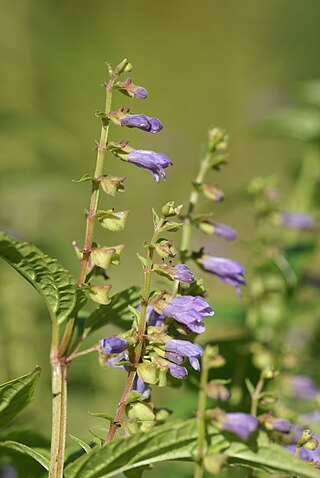
Rosaceae, the rose family, is a medium-sized family of flowering plants that includes 4,828 known species in 91 genera.

Flavonoids are a class of polyphenolic secondary metabolites found in plants, and thus commonly consumed in the diets of humans.

Lonicera japonica, known as Japanese honeysuckle and golden-and-silver honeysuckle, is a species of honeysuckle native to eastern Asia, including many parts of China. It is often grown as an ornamental plant, but has become an invasive species in a number of countries. Japanese honeysuckle is used in traditional Chinese medicine.

Epimedium, also known as barrenwort, bishop's hat, fairy wings, horny goat weed, or yin yang huo, is a genus of flowering plants in the family Berberidaceae. The majority of the species are endemic to China, with smaller numbers elsewhere in Asia, and a few in the Mediterranean region.

Catechin is a flavan-3-ol, a type of secondary metabolite providing antioxidant roles in plants. It belongs to the subgroup of polyphenols called flavonoids.

Passiflora incarnata, commonly known as maypop, purple passionflower, true passionflower, wild apricot, and wild passion vine, is a fast-growing perennial vine with climbing or trailing stems. A member of the passionflower genus Passiflora, the maypop has large, intricate flowers with prominent styles and stamens. One of the hardiest species of passionflower, it is both found as a wildflower in the southern United States and in cultivation for its fruit and striking bluish purple blooms.

Naringenin is a flavorless, colorless flavanone, a type of flavonoid. It is the predominant flavanone in grapefruit, and is found in a variety of fruits and herbs.

Cayaponia tayuya is a vine that grows in the Amazon region of South America, in the nations of Brazil, Bolivia and Peru. Its roots are used in herbal medicine.

Kaempferol (3,4′,5,7-tetrahydroxyflavone) is a natural flavonol, a type of flavonoid, found in a variety of plants and plant-derived foods including kale, beans, tea, spinach, and broccoli. Kaempferol is a yellow crystalline solid with a melting point of 276–278 °C (529–532 °F). It is slightly soluble in water and highly soluble in hot ethanol, ethers, and DMSO. Kaempferol is named for 17th-century German naturalist Engelbert Kaempfer.

Scutellaria lateriflora, is a hardy perennial herb of the mint family, Lamiaceae, native to North America.

Sophora flavescens, the shrubby sophora, is a species of plant in the genus Sophora of the family Fabaceae. This genus contains about 52 species, nineteen varieties, and seven forms that are widely distributed in Asia, Oceania, and the Pacific islands. About fifteen of these species have a long history of use in traditional Chinese medicines.

As baicalin is a flavone glycoside, it is a flavonoid. It is the glucuronide of baicalein.

Anthocyanins, also called anthocyans, are water-soluble vacuolar pigments that, depending on their pH, may appear red, purple, blue, or black. In 1835, the German pharmacist Ludwig Clamor Marquart gave the name Anthokyan to a chemical compound that gives flowers a blue color for the first time in his treatise "Die Farben der Blüthen". Food plants rich in anthocyanins include the blueberry, raspberry, black rice, and black soybean, among many others that are red, blue, purple, or black. Some of the colors of autumn leaves are derived from anthocyanins.

Icariin is a chemical compound classified as a prenylated flavonol glycoside, a type of flavonoid. It is the 8-prenyl derivative of kaempferol 3,7-O-diglucoside. The compound has been isolated from several species of plant belonging to the genus Epimedium which are commonly known as horny goat weed, Yin Yang Huo, and Herba epimedii. Extracts from these plants are reputed to produce aphrodisiac effects, and are used in traditional Chinese medicine to enhance erectile function. However, clinical trial data are lacking to support these claims.

Baicalein (5,6,7-trihydroxyflavone) is a flavone, a type of flavonoid, originally isolated from the roots of Scutellaria baicalensis and Scutellaria lateriflora. It is also reported in Oroxylum indicum and Thyme. It is the aglycone of baicalin. Baicalein is one of the active ingredients of Sho-Saiko-To, which is a Chinese classic herbal formula, and listed in Japan as Kampo medicine.

3-Hydroxyflavone is a chemical compound. It is the backbone of all flavonols, a type of flavonoid. It is a synthetic compound, which is not found naturally in plants. It serves as a model molecule as it possesses an excited-state intramolecular proton transfer (ESIPT) effect to serve as a fluorescent probe to study membranes for example or intermembrane proteins. The green tautomer emission and blue-violet normal emission originate from two different ground state populations of 3HF molecules. The phenomenon also exists in natural flavonols. Although 3-hydroxyflavone is almost insoluble in water, its aqueous solubility can be increased by encapsulation in cyclodextrin cavities.

Prenylated flavonoids or prenylflavonoids are a sub-class of flavonoids. They are widely distributed throughout the plant kingdom. Some are known to have phytoestrogenic or antioxidant properties. They are given in the list of adaptogens in herbalism. Chemically they have a prenyl group attached to their flavonoid backbone. It is usually assumed that the addition of hydrophobic prenyl groups facilitate attachment to cell membranes. Prenylation may increase the potential activity of its original flavonoid.

Polyporus umbellatus is an edible species of mushroom, found growing on roots of old beeches or oak (e.g.). It is also called lumpy bracket and umbrella polypore.

Justicia gendarussa, commonly known as willow-leaved justicia ,Lapsulis in Creole Seychelles; is a small erect, branched shrub. It has been described as rare and endemic to India, though those claims are at least confusing, in the context of statements that the plant is widely used in various forms for many of its medicinal and insecticidal properties, and that it is a quick-growing, evergreen forest shrub considered to be a native of China and distributed in Sri Lanka, India and Malaysia. J. Gendarussa is harvested for its leaves for the treatment of various ailments.

Morus mongolica, also described as Morus alba var. mongolica, is a woody plant native to mountain forests in Mongolia, China, Korea, and Japan. Common names include Mongolian mulberry, meng sang (China), and ilama by native people in the namesake region of Mongolia. Similar to M. notabilis, M. mongolica is an uncultivated mulberry.




















